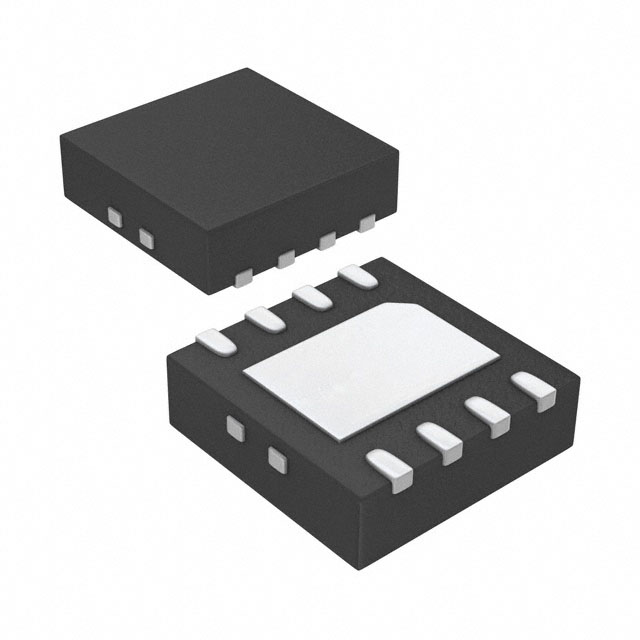Viz Specifikace pro podrobnosti o produktu.

LTC4301IDD#TRPBF
Product Overview
Category: Integrated Circuit (IC)
Use: Level Translator and Buffer
Characteristics: - Bidirectional I2C Bus Buffer - Compatible with I2C Standard Mode, Fast Mode, and Fast Mode Plus - Supports Clock Stretching - Low Voltage Operation (1.65V to 5.5V) - High Noise Margin (0.3V) - Low Quiescent Current (1µA) - Available in DFN-8 Package
Package: DFN-8 (Dual Flat No-Lead)
Essence: The LTC4301IDD#TRPBF is a bidirectional I2C bus buffer designed to provide level translation and buffering between two I2C buses operating at different voltage levels.
Packaging/Quantity: The LTC4301IDD#TRPBF is available in tape and reel packaging, with 2500 units per reel.
Specifications
- Supply Voltage Range: 1.65V to 5.5V
- Operating Temperature Range: -40°C to 85°C
- Maximum Input High Voltage: VCC + 0.3V
- Minimum Input Low Voltage: GND - 0.3V
- Quiescent Current: 1µA (typical)
- Rise Time and Fall Time: 20ns (maximum)
- Maximum Capacitive Load: 400pF
Pin Configuration
The LTC4301IDD#TRPBF has the following pin configuration:
___________
SDA1 | 1 8 | SDA2
SCL1 | 2 7 | SCL2
GND | 3 6 | VCC
EN | 4 5 | ADR
‾‾‾‾‾‾‾‾‾‾
Functional Features
- Bidirectional level translation between two I2C buses operating at different voltage levels.
- Compatible with I2C Standard Mode (100kHz), Fast Mode (400kHz), and Fast Mode Plus (1MHz).
- Supports clock stretching, allowing devices on the bus to slow down communication if needed.
- Provides high noise margin of 0.3V, ensuring reliable data transfer in noisy environments.
- Low quiescent current of 1µA, minimizing power consumption.
- Enables connection of multiple I2C devices with different voltage requirements.
Advantages
- Simplifies interfacing between I2C devices operating at different voltage levels.
- Supports various I2C bus speeds, providing flexibility in system design.
- Allows for reliable communication in noisy environments.
- Low power consumption helps extend battery life in portable devices.
- Compact DFN-8 package saves board space.
Disadvantages
- Limited to I2C bus applications and may not be suitable for other communication protocols.
- Requires careful consideration of voltage level compatibility between connected devices.
- May introduce additional propagation delay in the bus due to level translation.
Working Principles
The LTC4301IDD#TRPBF acts as a bidirectional buffer and level translator for I2C bus signals. It provides voltage level shifting between two I2C buses operating at different voltage levels, allowing them to communicate seamlessly.
The device monitors the bus lines for start conditions and controls the direction of data flow based on the logic level of the enable pin (EN). When EN is low, the LTC4301IDD#TRPBF operates in transmit mode, translating the logic levels from the lower voltage bus to the higher voltage bus. When EN is high, it operates in receive mode, translating the logic levels from the higher voltage bus to the lower voltage bus.
The LTC4301IDD#TRPBF also supports clock stretching, which allows devices on the bus to hold the clock line low to slow down communication if needed. This feature ensures compatibility with devices that require additional time for processing data.
Detailed Application Field Plans
The LTC4301IDD#TRPBF is commonly used in various applications where level translation and buffering between I2C buses are required. Some typical application fields include:
- Embedded Systems: Used in microcontroller-based systems to interface with I2C devices operating at different voltage levels.
- Industrial Automation: Enables communication between I2C sensors, actuators, and controllers with varying voltage requirements.
- Consumer Electronics: Facilitates connectivity between I2C devices in smartphones, tablets, and other consumer electronic devices.
- Automotive Electronics: Provides level translation for I2C communication in automotive systems, such as infotainment systems and advanced driver-assistance systems (ADAS).
- Medical Devices: Allows for seamless integration of I2C-based medical sensors and monitoring devices with different voltage levels.
Detailed and Complete Alternative Models
Seznam 10 běžných otázek a odpovědí souvisejících s aplikací LTC4301IDD#TRPBF v technických řešeních
Sure! Here are 10 common questions and answers related to the application of LTC4301IDD#TRPBF:
Q1: What is LTC4301IDD#TRPBF? A1: LTC4301IDD#TRPBF is a multiplexer/demultiplexer IC (Integrated Circuit) designed for I2C bus applications. It allows multiple devices to share a single I2C bus.
Q2: What is the purpose of LTC4301IDD#TRPBF? A2: The purpose of LTC4301IDD#TRPBF is to prevent bus contention and data corruption in multi-master I2C systems by providing bidirectional buffering, level shifting, and arbitration.
Q3: How does LTC4301IDD#TRPBF prevent bus contention? A3: LTC4301IDD#TRPBF uses a built-in arbitration scheme that ensures only one master device can control the bus at a time, preventing conflicts and data corruption.
Q4: Can LTC4301IDD#TRPBF be used in both 5V and 3.3V systems? A4: Yes, LTC4301IDD#TRPBF supports both 5V and 3.3V systems. It provides level shifting capabilities to allow communication between devices operating at different voltage levels.
Q5: How many devices can be connected to the I2C bus using LTC4301IDD#TRPBF? A5: LTC4301IDD#TRPBF can support up to 400 devices on the I2C bus, depending on the system's capacitance and pull-up resistor values.
Q6: Does LTC4301IDD#TRPBF require external components? A6: Yes, LTC4301IDD#TRPBF requires external pull-up resistors and decoupling capacitors for proper operation.
Q7: Can LTC4301IDD#TRPBF be used in hot-swapping applications? A7: Yes, LTC4301IDD#TRPBF supports hot-swapping, allowing devices to be added or removed from the I2C bus without disrupting communication.
Q8: What is the maximum operating frequency of LTC4301IDD#TRPBF? A8: The maximum operating frequency of LTC4301IDD#TRPBF is 400kHz, which is the standard frequency for I2C communication.
Q9: Does LTC4301IDD#TRPBF have built-in ESD protection? A9: Yes, LTC4301IDD#TRPBF has built-in ESD (Electrostatic Discharge) protection, ensuring robustness against static electricity.
Q10: Is LTC4301IDD#TRPBF available in different package options? A10: Yes, LTC4301IDD#TRPBF is available in various package options, including DFN and MSOP, providing flexibility for different PCB layouts and space constraints.
Please note that the answers provided here are general and may vary depending on the specific application and requirements. It is always recommended to refer to the datasheet and consult with the manufacturer for detailed information.

